by Kennedy Ushiroda and Hallie Gleeson
From Hallie’s Aisle
The lights went off.
The band came on.
Cimarrón.

From the very top row, students had a bird’s eye view of the entire stage and audience. As concert-goers streamed into Weisiger for the first performance of the fall, the theater welcomed a crowd filled with uncertain expectations.
“Promptly” at 7:32, Steve Hoffman took the stage to commemorate Norton’s 50th anniversary and welcome Cimarrón to their first official stop on the US leg of their tour! (The band made an emergency stop at Waffle House after an arduous airport fiasco.)
Clad in glitzy shawls and cowboy hats, five musicians entered with calm smiles.
With a rapid shout, the show began.
A jaunty harp solo was quickly joined by pounding drum beats and the confident strumming of two guitars and a cello. With impressive coordination, the quintet played a song with a blend of traditional and modern music. More importantly, the music was fast, fast, fast.

After a purely instrumental introduction, a lady draped in turquoise ruffles sauntered on stage, greeted with cheers from the audience. With an enchanting smile, she began to passionately belt lyrics. Behind her, the band continued at their break-neck pace. Vibrant music pulsed through the floor and up into the audience.
The strum of instruments suddenly ceased, and one member stepped forward to unleash a furious tap dance. Navigating a careful contrast between shyness and boldness, he jumped back to his instrument and captured the heartstrings of the audience with his harp strings.

Throughout the ninety-minute show, this pattern repeated, allowing each member to shine. Occasionally, I found myself thinking that each part could have been trimmed down slightly to allow for more variety. The songs sounded repetitive sometimes because the volume never varied.
No crescendos for this band! Every moment was either zero or one hundred (both in volume and in speed). Even if some of the audio could have been more polished, this was still a jewel of a show. The wild and untamed music was full of life and soul; Cimarrón lives up to their name.
The multiple costume changes, maracas shake-down battle, synchronized tap dancing, and the final delve into a flurry of acrobatics were paired perfectly with the tempo.
As the show came to a dramatic finish, I was left with a pounding pulse and a lingering question:
How much of the band’s budget is allotted to replacing broken strings?
…
From Kennedy’s Aisle
A bustling crowd appeared for Weisiger Theater’s first show, Cimarrón. Spanish for “wild” or “untamed,” “cimarrón” perfectly encapsulates the style of music. The explosive, vibrant Colombian band featured musical instruments like the guitar (bandola and cuatro), drums, cello, and harp. After spending their first night at the airport, the band had their first meal at the quintessentially American restaurant chain, Waffle House. Centre College had the privilege to host the breathtaking band’s first US tour opening.
After Steve Hoffman finished Cimarrón’s introduction, the entire hall of concertgoers held their breath. The quintet of men donned big, white, flamboyant cowboy hats with an all-black under-attire fashioned with light-colored sandals. The band members were shy in their outward attitudes. They hovered around their instruments as though it were an extension of themselves, but the moment they started playing, their timidness evaporated. A quick and powerful Spanish count up launched their start with furious strumming and beating, with meticulous, fast-paced fingering. Everyone on stage communicated with their eyes; no singing yet.
Then the woman of the hour sauntered on stage donned a layered, deep cerulean dress, matching her men with a blue cowboy hat. She took no time in belting out powerful Spanish lyrics against the fast-paced symphony of the band behind her. The men of the band communicated with knowing glances and side smiles, perfectly attuned to make the singer shine in all her glory. The band members seemed to revere their singer, looking to her as if she were their queen. After finishing her song, she gracefully exited the stage to let her men continue their interludes.

Every member of the band shined. Whether it be the harp solo or the bandola interlude, each member of the ensemble displayed their virtuosity by playing their etudes in an impossibly fast speed. But together, their parts formed an organism bigger than themselves. Breaths of life, music, and color all worked together to create bubbling energy and soulful vibes. But music was not the only talent they displayed. Their white sandals acted as instruments of their own as they tap-danced front and center on stage.
When the beloved singer returned, she shocked the crowd with a costume change. Now in a more moody tone, two of the men put on red veils and blew into animal antlers to create a rhythmic and ominous whistle. The singer wore a white wedding gown and red latex gloves that covered her forearms. On her head stood a towering crown, covered in a white veil that extended three feet above her head.

With the final costume change, the singer was dressed in what appeared to be bull horns (about three feet long) and the same red dress and gloves. It was evident that the band was not just about performing music, but telling a story through the outputs of music and performance. The singer became a bull, representing the fierce nature of the band.
The concert ended in an exciting maraca and slapbox battle between the members of the band. The crowd whooped and cheered as they indulged in the men’s explosive display of musical prowess. At the end, the singer reunited with the rest of the band to show one last “wild” and “untamed” performance that can only be described as Cimarrón.

